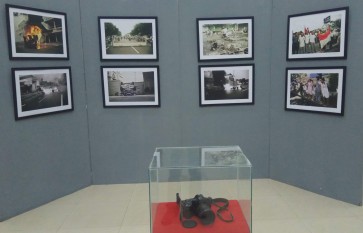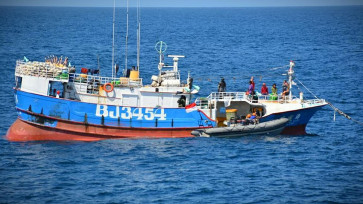Popular Reads
Top Results
Can't find what you're looking for?
View all search resultsPopular Reads
Top Results
Can't find what you're looking for?
View all search resultsIndonesian cosplayers win more hearts abroad than at home
Larger than life: Luffy (center) and fellow pirates devise a strategy to defeat their enemy, the marines, during the Cosplay Live Action Show: One Piece on May 11 to commemorate One Piece’s 20th anniversary
Change text size
Gift Premium Articles
to Anyone

L
arger than life: Luffy (center) and fellow pirates devise a strategy to defeat their enemy, the marines, during the Cosplay Live Action Show: One Piece on May 11 to commemorate One Piece’s 20th anniversary.(Courtesy of CLAS:H Cosplay)
The audience cheered when Admiral Kizaru was defeated by Luffy, the hyperactive protagonist known for his straw hat and his pirate troops. The audience raised light sticks in a gesture to “banish” the antagonist admiral dressed in a yellow striped suit and white cape and wearing retro sunglasses.
Before the curtain call, all the cast members descended from the stage and greeted the audience while singing the “We Are!” theme song from the One Piece anime.
Budding pirate Luffy is the central character in the original manga series in his quest to embark from the East Blue Sea to find the famed One Piece treasure.
The cast members participated in the cosplay, short for costume play, as part of the Cosplay Live Action Show: One Piece on May 11, which was held to commemorate the popular anime’s 20th anniversary at Bulungan Theater in South Jakarta.
Cosplay, part of Japanese subculture introduced in the 1980s, has been popular in Indonesia since the 1990s. It entails not only the wearing and creating of characters’ costumes but also the performing of roles.
Among the audience of 300 people was Fikri Naufal, 23, a private employee from Tangerang, Banten.
“It was the first time I have watched a cosplay in a theatrical performance. I have been a fan of One Piece since I was a little boy. I think they [the performers] performed it very well,” he said.
Konnichi, 26, a project leader who played Luffy, said the show marked the first-time a cosplay performance in Indonesia had combined live stage action and cabaret with on-screen visualization.
At the lively One Piece cosplay performance, Konnichi somersaulted and jumped around on the stage, showing his versatile ability in capoeira, parkour and theater.
He is one of approximately 10,000 cosplayers nationwide, spread across the archipelago from Palembang in South Sumatra to Manokwari in Papua.
Konnichi and other experienced cosplayers held the event as a part of the Indonesian cosplay community’s gathering amid preparations for national and international cosplay competitions.
Indonesia has participated in the World Cosplay Summit (WCS) since 2012. It is an annual international cosplay competition that was established in Nagoya, Japan, in 2003.
Indonesian cosplayers have gained international recognition after winning the second runner-up titles in 2012 and 2014, the first runner-up title in 2018 and the grand champion title in 2016.
The WCS has since 2018 gained support from Japan’s Foreign Ministry, Economic, Trade and Industry Ministry and Land, Infrastructure and Transportation Ministry. Each winner receives a prize from the foreign ministry and the participants get the honor of visiting its office.
Even though Indonesian cosplay performances have received attention abroad, they are still struggling for domestic recognition.
“Since 2013, we have hoped for appreciation from the Indonesian government or the Indonesian Embassy in Japan, but we have yet to receive a positive response,” said Zhuge Kameya, 33, who represented Indonesia in its first WCS participation.
“The Japanese ambassador in Indonesia, in fact, often attends the ICGP,” he said, referring to the Indonesia Cosplay Grand Prix.
The ICGP is an annual national-level cosplay competition that is held in six big cities — Jakarta, Medan in North Sumatra, Bandung in West Java, Malang in East Java, Denpasar in Bali and Yogyakarta. It aims to nurture and scout local talent to represent Indonesia in the WCS.
“The ICGP is one of the strictest national-level cosplay competitions in the world. That is why our talent can win at the WCS. Compared to other countries, our costumes are often lacking in quality and detail, but we can portray the characters in a livelier manner,” said Zhuge.
Although cosplay has become a platform for creativity and self-expression both nationally and internationally, negative stereotyping and skepticism have been prevalent since the dawn of cosplay.
“When cosplay was relatively new in Indonesia, for example, people often said it was crazy. ‘Just do normal theater,’ some people said to me,” Zhuge recalled when asked about his early years of cosplaying.
Cosplayers often concealed their identities and introduced themselves using their stage names because they were often embarrassed or afraid that they would be fired from their jobs.
The habit of adopting stage names, usually inspired by Japanese characters, is now followed by most cosplayers in the world, including Zhuge and Konnichi.
Some Indonesian cosplayers also hide their hobby even from family members.
“They leave home wearing regular clothes and change into their costumes at a friend’s house or at the venue,” said Ranny Rastati from the Research Center for Society and Culture at the Indonesia Institute of Sciences (PMB LIPI).
Some family members are not supportive when it comes to cosplay because it is a costly hobby. If cosplayers craft their own costumes, their parents tend to support them because they consider it a positive hobby that can enhance creativity. But if cosplayers buy avant-garde costumes that cost more than Rp 10 million (US$694), their parents consider it a negative effect of cosplay.
Even so, Ranny, as someone who has followed the cosplay trend for nine years, said she witnessed how cosplay could change and encourage sense of self-worth in many young people.
“Can you imagine? Someone who used to be ignored by society has suddenly become an idol,” Ranny said. “He has become more enthusiastic and passionate about creating works that can inspire others. Stories like this are barely understood by those outside the cosplay community.” (asp/eyc/syk)









